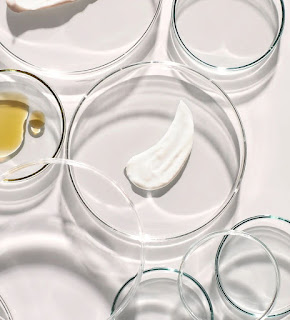Preservatives in skincare. What are they?
Cosmetic products need to be be preserved in order to prevent microbial spoilage that would make the product unsafe for consumers.
Preservatives play a very important function in products containing water: they kill microorganisms and prevent the growth of bacteria, mold and yeast. If a product contains water (including hydrosols, floral water and aloe vera juice, all of which contain water), a preservative is essential to help prevent microbes growing.
Anhydrous (water-free) products generally don’t require preservatives as they are not prone to microbial contamination. This includes products like lip balms and anhydrous whipped body butters. The exception here is an anhydrous product that might come into contact with water (eg a body scrub or a cleansing balm applied with wet fingers). With these types of products you either need to be very careful not to introduce water to the product during use, or you should include an oil based preservative.
You will need to use a broad-spectrum preservative, which means it is effective against bacteria, mold and yeast.
It’s important to follow the manufacturer’s instructions regarding the amount of preservative to use; too much or too little could be potentially hazardous.
The only way to know that your preservative is working effectively is to have a microbiological challenge test carried out by a lab. This is recommended (and in some countries compulsory) if you are selling your products.
Broad Spectrum preservatives for cosmetic products
The preservatives in the list below are all approved for use in certified organic products. They are either derived from natural sources or are nature identical.
Notes: It is your responsibility to check the efficacy of your preservative system. We strongly recommend having a microbiological challenge test carried out by a lab as this is the only way to be completely sure that your preservative system is effective.
1. Preservative Eco/Geogard ECT
INCI: Benzyl Alcohol (and) Salicylic Acid (and) Glycerin (and) Sorbic Acid
This is a broad spectrum preservative which contains four different components: Benzyl Alcohol, Salicylic Acid, Glycerin and Sorbic Acid. These molecules are all found in nature in plants such as pine resin, rowan berries and willow bark. It is a non-paraben, non-formaldehyde, non-isothiazolone based preservative system.
It’s a liquid that is added to the cooling phase of a cream. It has a slight almond-like smell that is normally not detectable in the finished product. Over time, benzyl alcohol oxidizes to benzaldehyde, which has a strong almond smell. Suitable for use in oil-in-water, water-in-oil and water based formulas, so compatible with a wide range of skin, hair and sun care formulations.
It’s usually used at 1% in water based products.
2) Euxyl PE 9010/Plantaserve E
INCI: Phenoxyethanol and Ethylhexylglycerin
Euxyl® PE 9010 (also known as Plantaserve) is a broad-spectrum preservative used in cosmetics and toiletries. This preservative is a mixture that includes a high concentration of phenoxyethanol with ethylhexylglycerin – which further interferes with unwanted microorganisms at their cell membrane. Good manufacturing practices (GMP) should be executed – preservatives should not be made to take up the absence of GMP as it reduces their efficacy.
It is an oil soluble preservative, therefore it works well in anhydrous products
Usage rate is between 0.5 – 1.1%.
pH Stability: 3.0 – 12.0
3) Germall plus liquid
INCI: Propylene Glycol, Diazolidinyl Urea, and Iodopropynyl Butylcarbamate.
Liquid Germall Plus is a broad-spectrum preservative. It is most effective against the growth of gram-positive & gram-negative bacteria, yeasts, and molds. It is cost-effective, easy to use, and highly effective at low concentrations. It is compatible with virtually all cosmetic ingredients except for products intended to be aerosolized.
Solubility: Water
Use rate: 0.1 – 0.5%
pH Stability: 3.0 – 8.0
4) Optiphen Plus
INCI: Phenoxyethanol (and) Caprylyl Glycol (and) Sorbic Acid
Optiphen™ Plus preservative by Ashland Specialty Chemical is a preservative. It is free of paraben, formaldehyde, or halogens. It provides broad-spectrum protection against bacteria, yeast, fungi, and mould. It offers excellent heat stability, works across a wide pH window, and has easy solubilization in water.
Optiphen™ Plus preservative is ideal for slightly acidic personal care products. It performs best in formulations below 6.0 pH but is also proven effective at pH levels above 6.0. In formulations with low emulsifier concentration, intensive stirring is advised.
Use rate: 0.75 – 1.5%
pH Stability: ≤6.0
5. Geogard 221
INCI: Benzyl Alcohol (and) Dehydroacetic Acid
An Ecocert approved, multi-use, broad spectrum preservative system that is a synergistic blend of an organic acid and alcohol that can be added at room and elevated temperatures. Dehydroacetic Acid and Benzyl Alcohol are both organic compounds which are accepted for use in natural cosmetics, offering a broad spectrum of stability at a wide range of pH. The organic preservative compound is a non-paraben, non-formaldehyde, non isothiazolone based preservative system.
It is water soluble with an effective pH from pH 2-6; it’s most efficient at pH below 5.5.
Typical recommended use level is 0.2-1%
Hope you find this blog post helpful. Leave me a comment below if you do ♥️




Comments
Post a Comment